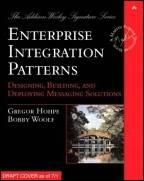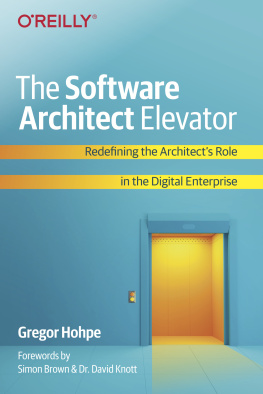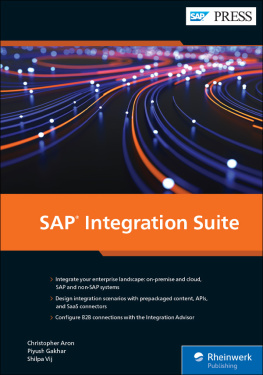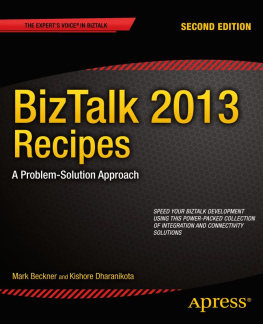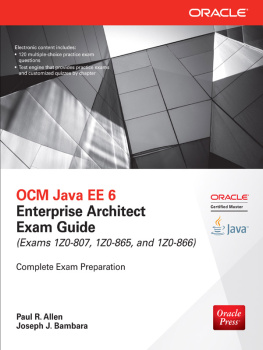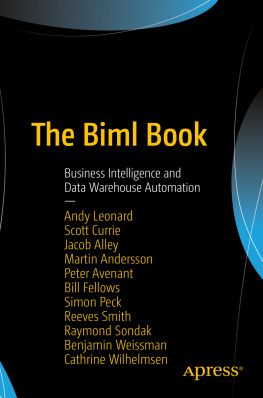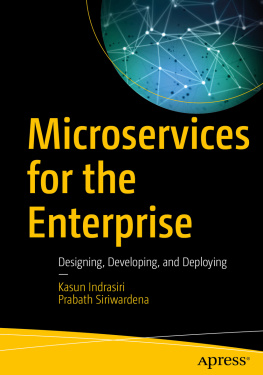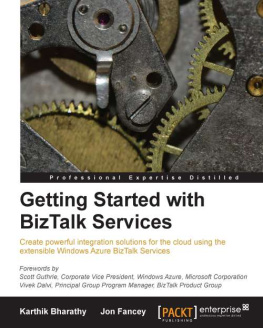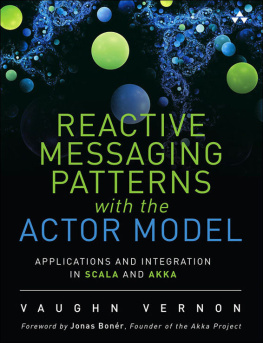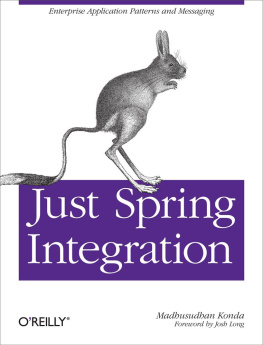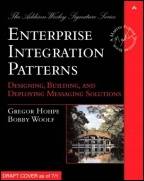| Enterprise Integration Patterns: Designing, Building, and Deploying Messaging Solutions |
| By Gregor Hohpe, Bobby Woolf |
| Publisher | : Addison Wesley |
| Pub Date | : October 10, 2003 |
| ISBN | : 0-321-20068-3 |
| Pages | : 736 |
Would you like to use a consistent visual notation for drawing integration solutions? Look inside the front cover.
Do you want to harness the power of asynchronous systems without getting caught in the pitfalls? See "Thinking Asynchronously" in the Introduction.
Do you want to know which style of application integration is best for your purposes? See Chapter 2, Integration Styles.
Do you want to learn techniques for processing messages concurrently? See Chapter 10, Competing Consumers and Message Dispatcher.
Do you want to learn how you can track asynchronous messages as they flow across distributed systems? See Chapter 11, Message History and Message Store.
Do you want to understand how a system designed using integration patterns can be implemented using Java Web services, .NET message queuing, and a TIBCO-based publish-subscribe architecture? See Chapter 9, Interlude: Composed Messaging.
Utilizing years of practical experience, seasoned experts Gregor Hohpe and Bobby Woolf show how asynchronous messaging has proven to be the best strategy for enterprise integration success. However, building and deploying messaging solutions presents a number of problems for developers. Enterprise Integration Patterns provides an invaluable catalog of sixty-five patterns, with real-world solutions that demonstrate the formidable of messaging and help you to design effective messaging solutions for your enterprise.
The authors also include examples covering a variety of different integration technologies, such as JMS, MSMQ, TIBCO ActiveEnterprise, Microsoft BizTalk, SOAP, and XSL. A case study describing a bond trading system illustrates the patterns in practice, and the book offers a look at emerging standards, as well as insights into what the future of enterprise integration might hold.
This book provides a consistent vocabulary and visual notation framework to describe large-scale integration solutions across many technologies. It also explores in detail the advantages and limitations of asynchronous messaging architectures. The authors present practical advice on designing code that connects an application to a messaging system, and provide extensive information to help you determine when to send a message, how to route it to the proper destination, and how to monitor the health of a messaging system. If you want to know how to manage, monitor, and maintain a messaging system once it is in use, get this book.
Copyright
Many of the designations used by manufacturers and sellers to distinguish their products are claimed as trademarks. Where those designations appear in this book, and Addison-Wesley was aware of a trademark claim, the designations have been printed with initial capital letters or in all capitals.
The authors and publisher have taken care in the preparation of this book, but make no expressed or implied warranty of any kind and assume no responsibility for errors or omissions. No liability is assumed for incidental or consequential damages in connection with or arising out of the use of the information or programs contained herein.
The publisher offers discounts on this book when ordered in quantity for bulk purchases and special sales. For more information, please contact:
U.S. Corporate and Government Sale
(800) 382-3419
For sales outside of the U.S., please contact:
International Sales
(317) 581-3793
Visit Addison-Wesley on the Web: www.awprofessional.com
Library of Congress Cataloging-in-Publication Data
Hohpe, Gregor.
Enterprise integration patterns : designing, building, and deploying messaging
solutions / Gregor Hohpe, Bobby Woolf.
p. cm.
Includes bibliographical references and index.
ISBN 0-321-20068-3
1. TelecommunicationMessage processing. 2. Management information
systems. I. Woolf, Bobby. II. Title.
TK5102.5.H5882 2003
005.7'136dc22
2003017989
Copyright 2004 by Pearson Education, Inc.
All rights reserved. No part of this publication may be reproduced, stored in a retrieval system, or transmitted, in any form, or by any means, electronic, mechanical, photocopying, recording, or otherwise, without the prior consent of the publisher. Printed in the United States of America. Published simultaneously in Canada.
For information on obtaining permission for use of material from this work, please submit a written request to:
Pearson Education, Inc.
Rights and Contracts Department
75 Arlington Street, Suite 300
Boston, MA 02116
Fax: (617) 848-7047
Text printed on recycled paper
1 2 3 4 5 6 7 8 9 10CRS0706050403
First printing, October 2003
Dedication
To my family and all my friends who still remember me after I emerged from book "crunch mode"
Gregor
To Sharon, my new wife
Bobby
The Addison-Wesley Signature Series
The Addison-Wesley Signature Series provides readers with practical and authoritative information on the latest trends in modern technology for computer professionals. The series is based on one simple premise: great books come from great authors. Books in the series are personally chosen by expert advisors, world-class authors in their own right. These experts are proud to put their signatures on the covers, and their signatures ensure that these thought leaders have worked closely with authors to define topic coverage, book scope, critical content, and overall uniqueness. The expert signatures also symbolize a promise to our readers: you are reading a future classic.
The Addison-Wesley Signature Series
S IGNERS: K ENT B ECK AND M ARTIN F OWLER
Kent Beck has pioneered people-oriented technologies like JUnit, Extreme Programming, and patterns for software development. Kent is interested in helping teams do well by doing good finding a style of software development that simultaneously satisfies economic, aesthetic, emotional, and practical constraints. His books focus on touching the lives of the creators and users of software.
Martin Fowler has been a pioneer of object technology in enterprise applications. His central concern is how to design software well. He focuses on getting to the heart of how to build enterprise software that will last well into the future. He is interested in looking behind the specifics of technologies to the patterns, practices, and principles that last for many years; these books should be usable a decade from now. Martin's criterion is that these are books he wished he could write.
Titles in the Series

Test-Driven Development: By Example
Kent Beck, ISBN: 0321146530

Patterns of Enterprise Application Architecture
Martin Fowler, ISBN: 0321127420
Beyond Software Architecture: Creating and Sustaining Winning Solutions
Luke Hohmann, ISBN: 0201775948
Enterprise Integration Patterns: Designing, Building, and Deploying Messaging Solutions
Next page
